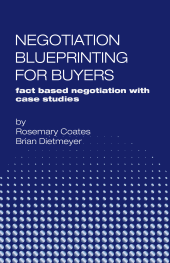foreward by brian dietmeyer
It may sound cliché but the very nature of buying and selling has changed dramatically. Some of this change is due to the global economic shifts, the availability of data and the changing role of both buyer and seller. While some economies continue to struggle, others are expanding at a rapid rate. Additionally, the availability of supplier data, software that supports turning that data into insight has shifted the buy/sell process and created a dynamic where both sides have more information earlier in the negotiating process. Sellers are being trained to place more emphasis on selling solutions that solve customer problems and create true measurable business value. Buyers are being asked to source products and services that are in alignment with and support of specific company strategies, key initiatives to forward that strategy and improvement of operational process.
All of these shifts point to the need for a change in the way buyers approach negotiating deals with suppliers. With the advent of these changes, it’s time to think of a new paradigm for supplier negotiation. Part of that paradigm shift is reframing negotiation as decision making. As a professional buyer it is incumbent upon you to make decisions on supplier selection and negotiate final deals that are in alignment with corporate strategy.
• You make decisions on which supplier provides the mostoverall value for our company
• You make decisions on how suppliers get compensated inexchange for that value
The key enabler for enhanced decision making is data. In this sense, data is understanding the needs and business drivers for multiple stakeholders on both the buy and sell side. At Think! Inc. we think of negotiation as a very complex decision. There are multiple stakeholders in both organizations that are evaluating multiple aspects of their alternative to reaching agreement as well as evaluating the terms for reaching agreement. In a typical negotiation there may be 40–50 moving parts.
One other paradigm shift is something we call “reverse selling.” In our work over the last 16 years we’ve seen that the most difficult negotiations are those with strategic or single source suppliers. These are situations where it appears the supplier has more power due to the difficulty of high switching costs or simply no viable alternatives. What we will talk about is how to increase our leverage in these situations by becoming a more strategic and valued customer. The approach we will prescribe has to be “consumable” by those who use it. Many negotiation-planning processes are too complex and just not realistic for us to execute given our daily demands. In this book, we have narrowed down the negotiating data to that which really matters.
We have embedded three major concepts into what we refer to as a Value Blueprint. This Blueprint and the data that populates it are the underlying structure of every business deal. It expands and contracts in relation to the time you have and the complexity of the negotiation. We have attempted to build in as many case studies as possible to move this from a book that talks theory to one of practical application that helps make better business decisions.
Finally, this book is written by two people with 50 plus years of experience on both the buy and sell sides of deals. The benefit to you as a reader is an understanding of holistic thinking and analysis based on multiple internal customer needs on our side and multiple stakeholders on the sales side.
to purchase book
Click here.

